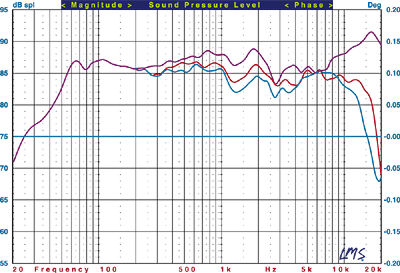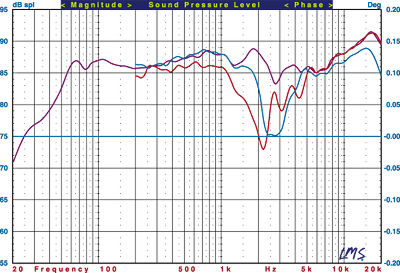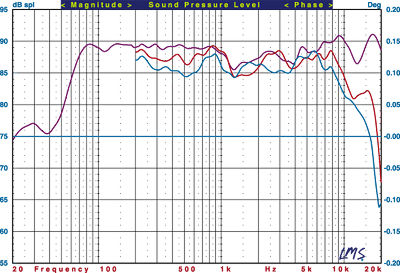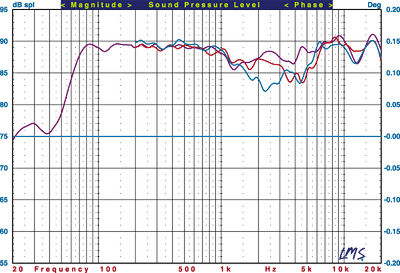Vienna Acoustics Strauss surround speaker system Measurements
The Vienna Acoustics Strauss's sensitivity measured about 87dB/W/m. The ported enclosure of the Strauss appeared to be heavily damped, making a clear determination of its loading frequency difficult. But judging from the impedance plots below 90Hz, there were significant differences between the two samples in their low-frequency loading. The sample whose measurements are presented here appeared to be tuned to a significantly higher frequency than the other, suggesting some production inconsistencies in either the woofers themselves or in the amount of damping material used in the cabinets. The sample's fully measured minimum impedance was 2.7ohms at 50Hz. I would judge the nominal impedance to be 6ohms. Fortunately, the impedance's phase angle is relatively low. The Strauss seems to be a moderately difficult load, but any stable amplifier comfortable with loads that dip below 4ohms (i.e., many separate amps but few receivers) should be able to drive it.
The Strauss's pseudo-anechoic response at tweeter height, averaged over a 30° forward horizontal angle and combined with the nearfield responses of the woofer and port, is shown in Fig.1 (violet). The useful bass extends down to approximately 33Hz (–10dB relative to the output at 100Hz). The on-axis average is a little bumpy, but the average deviation across most of the range is within ±2dB. Nevertheless, the deviations are significant enough to suggest some audible forwardness through the midrange and a bit of added zip in the extreme high frequencies. But SS noticed no such anomalies, perhaps because the off-axis results are noticeably smoother, which should result in an overall in-room response a bit more linear than the 30° average shown.

Fig.1: Vienna Acoustics Strauss, pseudo-anechoic horizontal response at 45° (red) and 60° (blue) relative to tweeter axis.
All figures: Violet: Pseudo-anechoic response on tweeter axis, averaged across a 30° horizontal window, combined with nearfield responses of woofer and port.
Fig.2 again shows the Strauss's averaged horizontal front response (violet), plus the vertical responses taken at +15° (red) and –15° (blue) relative to the tweeter. These measurements were taken with the speaker set up as intended: with its dedicated base providing a significant backtilt. As you move up or down off the vertical axis, a significant suckout appears in the response near what may be the (unspecified) mid/tweeter crossover point, which you should keep in mind when auditioning the speaker: Sit down and keep your ears as close to tweeter height as possible.

Fig.2: Vienna Acoustics Strauss, pseudo-anechoic vertical response at +15° (red) and –15° (blue) relative to tweeter axis.
Like the Strauss, the ported loading of the Oratorio is atypical, making precise interpretation of its loading frequency difficult. I would rate its nominal impedance at 4ohms; the minimum impedance was 2.4ohms at 78Hz. The sensitivity measured approximately 89dB/W/m; its overall impedance characteristic suggests that, like the Strauss, the Oratorio should be moderately difficult to drive—acceptable for many well-designed, separate amps but unsuitable for receivers, most of which are uncomfortable with low-impedance loads.
The Oratorio's measured front horizontal response, taken on the tweeter axis and averaged in the same manner as described above for the Strauss, is shown in Fig.3 (violet). The useful bass extension is approximately 52Hz (–10dB relative to the output at 100Hz). The 30° averaged response is smoother than that of the Strauss up to about 1kHz, and the overall curve indicates a somewhat laid-back quality through the low to mid-treble.

Fig.3: Vienna Acoustics Oratorio, pseudo-anechoic horizontal response at 45° (red) and 60° (blue) relative to tweeter axis.
The Oratorio's ±15° vertical off-axis performance (Fig.4) shows that the speaker performs best on-axis, with positions above the axis less detrimental than those below.—Thomas J. Norton

Fig.4: Vienna Acoustics Oratorio, pseudo-anechoic vertical response at +15° (red) and –15° (blue) relative to tweeter axis.





























































